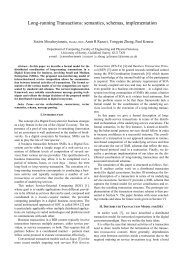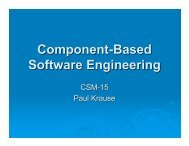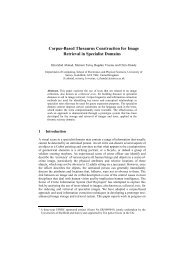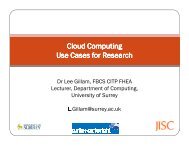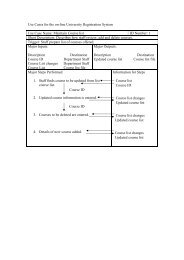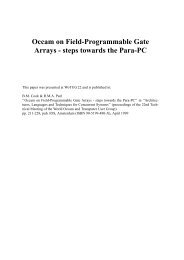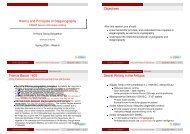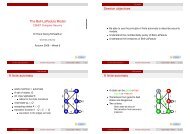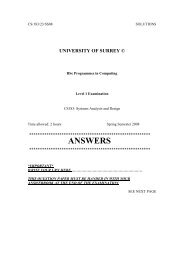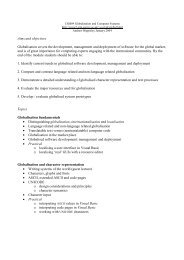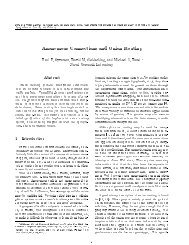A CSP account of Event-B refinement - Computing - University of ...
A CSP account of Event-B refinement - Computing - University of ...
A CSP account of Event-B refinement - Computing - University of ...
Create successful ePaper yourself
Turn your PDF publications into a flip-book with our unique Google optimized e-Paper software.
To appear in EPTCS.<br />
A <strong>CSP</strong> <strong>account</strong> <strong>of</strong> <strong>Event</strong>-B <strong>refinement</strong><br />
Steve Schneider<br />
Department <strong>of</strong> <strong>Computing</strong>, <strong>University</strong> <strong>of</strong> Surrey<br />
S.Schneider@surrey.ac.uk<br />
Heike Wehrheim<br />
Helen Treharne<br />
Department <strong>of</strong> <strong>Computing</strong>, <strong>University</strong> <strong>of</strong> Surrey<br />
H.Treharne@surrey.ac.uk<br />
Department <strong>of</strong> Computer Science, <strong>University</strong> <strong>of</strong> Paderborn<br />
wehrheim@uni-paderborn.de<br />
<strong>Event</strong>-B provides a flexible framework for stepwise system development via <strong>refinement</strong>. The framework<br />
supports steps for (a) refining events (one-by-one), (b) splitting events (one-by-many), and (c)<br />
introducing new events. In each <strong>of</strong> the steps events can moreover possibly be anticipated or convergent.<br />
All such steps are accompanied with precise pro<strong>of</strong> obligations. Still, it remains unclear what<br />
the exact relationship - in terms <strong>of</strong> a behaviour-oriented semantics - between an <strong>Event</strong>-B machine<br />
and its <strong>refinement</strong> is. In this paper, we give a <strong>CSP</strong> <strong>account</strong> <strong>of</strong> <strong>Event</strong>-B <strong>refinement</strong>, with a treatment<br />
for the first time <strong>of</strong> splitting events and <strong>of</strong> anticipated events. To this end, we define a <strong>CSP</strong> semantics<br />
for <strong>Event</strong>-B and show how the different forms <strong>of</strong> <strong>Event</strong>-B <strong>refinement</strong> can be captured as <strong>CSP</strong><br />
<strong>refinement</strong>.<br />
1 Introduction<br />
<strong>Event</strong>-B [1] provides a framework for system development through stepwise <strong>refinement</strong>. Individual<br />
<strong>refinement</strong> steps are verified with respect to their pro<strong>of</strong> obligations, and the transitivity <strong>of</strong> <strong>refinement</strong><br />
ensures that the final system description is a <strong>refinement</strong> <strong>of</strong> the initial one. The <strong>refinement</strong> process allows<br />
new events to be introduced through the <strong>refinement</strong> process, in order to provide the more concrete<br />
implementation details necessary as <strong>refinement</strong> proceeds.<br />
The framework allows for a great deal <strong>of</strong> flexibility as to cover a broad range <strong>of</strong> system developments.<br />
The recent book [1] comprising case studies from rather diverse areas shows that this goal is actually met.<br />
The flexibility is a result <strong>of</strong> the different ways <strong>of</strong> dealing with events during <strong>refinement</strong>. At each step<br />
existing events <strong>of</strong> an <strong>Event</strong>-B machine need to be refined. This can be achieved by (a) simply keeping<br />
the event as is, (b) refining it into another event, possibly because <strong>of</strong> a change <strong>of</strong> the state variables, or<br />
(c) splitting it into several events 1 . Furthermore, every <strong>refinement</strong> step allows for the introduction <strong>of</strong> new<br />
events. To help reasoning about divergence, events are in addition classified as ordinary, anticipated or<br />
convergent. Anticipated and convergent events both introduce new details into the machine specification.<br />
Convergent events must not be executed forever, while for anticipated events this condition is deferred<br />
to later <strong>refinement</strong> steps. All <strong>of</strong> these steps come with precise pro<strong>of</strong> obligations; appropriate tool support<br />
helps in discharging these [3, 2]. <strong>Event</strong>-B is essentially a state-based specification technique, and pro<strong>of</strong><br />
obligations therefore reason about predicates on states.<br />
Like <strong>Event</strong>-B, <strong>CSP</strong> comes with a notion <strong>of</strong> <strong>refinement</strong>. In order to understand their relationship,<br />
these two <strong>refinement</strong> concepts need to be set in a single framework. Both formalisms moreover support<br />
a variety <strong>of</strong> different forms <strong>of</strong> <strong>refinement</strong>: <strong>Event</strong>-B by means <strong>of</strong> several pro<strong>of</strong> obligations related to<br />
<strong>refinement</strong>, out <strong>of</strong> which the system designer chooses an appropriate set; <strong>CSP</strong> by means <strong>of</strong> its different<br />
1 A fourth option is merging <strong>of</strong> events which we do not consider here.
2 A <strong>CSP</strong> <strong>account</strong> <strong>of</strong> <strong>Event</strong>-B <strong>refinement</strong><br />
semantic domains <strong>of</strong> traces, failures and divergences. The aim <strong>of</strong> this paper is to give a precise <strong>account</strong><br />
<strong>of</strong> <strong>Event</strong>-B <strong>refinement</strong> in terms <strong>of</strong> <strong>CSP</strong>’s behaviour-oriented process <strong>refinement</strong>. This will also provide<br />
the underlying results that support <strong>refinement</strong> in the combined formalism <strong>Event</strong>-B�<strong>CSP</strong>. Our work is<br />
thus in line with previous studies relating state-based with behaviour-oriented <strong>refinement</strong> (see e.g. [5,<br />
9, 4]). It turns out that <strong>CSP</strong> supports an approach to <strong>refinement</strong> consistent with that <strong>of</strong> <strong>Event</strong>-B. It<br />
faithfully reflects all <strong>of</strong> <strong>Event</strong>-B’s possibilities for <strong>refinement</strong>, including splitting events and new events.<br />
It moreover also deals with the <strong>Event</strong>-B approach <strong>of</strong> anticipated events as a means to defer consideration<br />
<strong>of</strong> divergence-freedom. Our results involves support for individual <strong>refinement</strong> steps as well as for the<br />
resulting <strong>refinement</strong> chain.<br />
The paper is structured as follows. The next section introduces the necessary background on <strong>Event</strong>-B<br />
and <strong>CSP</strong>. Section 3 gives the <strong>CSP</strong> semantics for <strong>Event</strong>-B based on weakest preconditions. In Section 4<br />
we precisely fix the notion <strong>of</strong> <strong>refinement</strong> used in this paper, both for <strong>CSP</strong> and for <strong>Event</strong>-B, and Section<br />
5 will then set these definitions in relation. It turns out that the appropriate <strong>refinement</strong> concept <strong>of</strong> <strong>CSP</strong> in<br />
this combination with <strong>Event</strong>-B is infinite-traces-divergences <strong>refinement</strong>. The last section concludes.<br />
2 Background<br />
We start with a short introduction to <strong>CSP</strong> and <strong>Event</strong>-B. For more detailed information see [17] and [1]<br />
respectively.<br />
2.1 <strong>CSP</strong><br />
<strong>CSP</strong>, Communicating Sequential Processes, introduced by Hoare [11] is a formal specification language<br />
aiming at the description <strong>of</strong> communicating processes. A process is characterised by the events it can<br />
engage in and their ordering. <strong>Event</strong>s will in the following be denoted by a1,a2,... or evt0,evt1,....<br />
Process expressions are built out <strong>of</strong> events using a number <strong>of</strong> composition operators. In this paper, we<br />
will make use <strong>of</strong> just three <strong>of</strong> them: interleaving (P1 ||| P2), executing two processes in parallel without<br />
any synchronisation; hiding (P \ N), making a set N <strong>of</strong> events internal; and renaming (f (P) and f −1 (P)),<br />
changing the names <strong>of</strong> events according to a renaming function f . If f is a non-injective function, f −1 (P)<br />
will <strong>of</strong>fer a choice <strong>of</strong> events b such that f (b) = a whenever P <strong>of</strong>fers event a.<br />
Every <strong>CSP</strong> process P has an alphabet αP. Its semantics is given using the Failures/Divergences/Infinite<br />
Traces semantic model for <strong>CSP</strong>. This is presented as U in [16] or FDI in [17]. The semantics <strong>of</strong> a process<br />
can be understood in terms <strong>of</strong> four sets, T,F,D,I, which are respectively the traces, failures, divergences,<br />
and infinite traces <strong>of</strong> P. These are understood as observations <strong>of</strong> possible executions <strong>of</strong> the process P, in<br />
terms <strong>of</strong> the events from αP that it can engage in.<br />
Traces are finite sequences <strong>of</strong> events from P’s alphabet: tr ∈ αP ∗ . The set traces(P) represents the<br />
possible finite sequences <strong>of</strong> events that P can perform. Failures will not be considered in this paper and<br />
are therefore not explained here.<br />
Divergences are finite sequences <strong>of</strong> events on which the process might diverge: perform an infinite<br />
sequence <strong>of</strong> internal events (such as an infinite loop) at some point during or at the end <strong>of</strong> the sequence.<br />
The set divergences(P) is the set <strong>of</strong> all possible divergences for P. Infinite traces u ∈ αP ω are infinite<br />
sequences <strong>of</strong> events. The set infinites(P) is the set <strong>of</strong> infinite traces that P can exhibit. For technical<br />
reasons it also contains those infinite traces which have some prefix which is a divergence.<br />
Definition 2.1 A process P is divergence-free if divergences(P) = {}.
S.Schneider, H. Treharne & H. Wehrheim 3<br />
machine M0<br />
variables v<br />
invariant I(v)<br />
events init0,evt0,...<br />
end<br />
evt0 �=<br />
when<br />
G(v)<br />
then<br />
v :| BA0(v,v ′ )<br />
end<br />
Figure 1: Template <strong>of</strong> an <strong>Event</strong>-B machine and an event.<br />
We use tr to refer to finite traces. These can also be written explicitly as 〈a1,a2,...,an〉. The empty trace<br />
is 〈〉, concatenation <strong>of</strong> traces is written as tr1 � tr2. We use u to refer to infinite traces. Given a set <strong>of</strong><br />
events A, the projections tr ↾ A and u ↾ A are the traces restricted to only those events in A. Note that u ↾ A<br />
might be finite, if only finitely many A events appear in u. Conversely, tr \ A and u \ A are those traces<br />
with the events in A removed. The length operator #tr and #u gives the length <strong>of</strong> the trace it is applied<br />
to. As a first observation, we get the following.<br />
Lemma 2.2 If P is divergence-free, and for any infinite trace u <strong>of</strong> P we have #(u \ A) = ∞, then P \ A is<br />
divergence-free.<br />
Pro<strong>of</strong> 2.3 Follows immediately from the semantics <strong>of</strong> the hiding operator.<br />
Later, we furthermore use specifications on traces or, more generally, on <strong>CSP</strong> processes. Specifications<br />
are given in terms <strong>of</strong> predicates. If S is a predicate on a particular semantic element, then we write P sat S<br />
to denote that all relevant elements in the semantics <strong>of</strong> P meet the predicate S. For example, if S(u) is a<br />
predicate on infinite traces, then P sat S(u) is equivalent to ∀u ∈ infinites(P).S(u).<br />
2.2 <strong>Event</strong>-B<br />
<strong>Event</strong>-B [1, 13] is a state-based specification formalism based on set theory. Here we describe the basic<br />
parts <strong>of</strong> an <strong>Event</strong>-B machine required for this paper; a full description <strong>of</strong> the formalism can be found in<br />
[1].<br />
A machine specification usually defines a list <strong>of</strong> variables, given as v. <strong>Event</strong>-B also in general allows<br />
sets s and constants c. However, for our purposes the treatment <strong>of</strong> elements such as sets and constants<br />
are independent <strong>of</strong> the results <strong>of</strong> this paper, and so we will not include them here. However, they can be<br />
directly incorporated without affecting our results.<br />
There are many clauses that may appear in <strong>Event</strong>-B machines, and we concentrate on those clauses<br />
concerned with the state. We will therefore describe a machine M0 with a list <strong>of</strong> state variables v, a state<br />
invariant I(v), and a set <strong>of</strong> events evt0,... to update the state (see left <strong>of</strong> Fig.1). Initialisation is a special<br />
event init0.<br />
A machine M0 will have various pro<strong>of</strong> obligations on it. These include consistency obligations, that<br />
events preserve the invariant. They can also include (optional) deadlock-freeness obligations: that at<br />
least one event guard is always true.<br />
Central to an <strong>Event</strong>-B description is the definition <strong>of</strong> the events, each consisting <strong>of</strong> a guard G(v)<br />
over the variables, and a body, usually written as an assignment S on the variables. The body defines<br />
a before-after predicate BA(v,v ′ ) describing changes <strong>of</strong> variables upon event execution, in terms <strong>of</strong> the<br />
relationship between the variable values before (v) and after (v ′ ). The body can also be written as v :|
4 A <strong>CSP</strong> <strong>account</strong> <strong>of</strong> <strong>Event</strong>-B <strong>refinement</strong><br />
BA(v,v ′ ), whose execution assigns to v any value v ′ which makes the predicate BA(v,v ′ ) true (see right<br />
<strong>of</strong> Fig. 1).<br />
3 <strong>CSP</strong> semantics for <strong>Event</strong>-B machine<br />
<strong>Event</strong>-B machines are particular instances <strong>of</strong> action systems, so Morgan’s <strong>CSP</strong> semantics for action systems<br />
[14] allows traces, failures, and divergences to be defined for <strong>Event</strong>-B machines, in terms <strong>of</strong> the<br />
sequences <strong>of</strong> events that they can and cannot engage in. Butler’s extension to handle unbounded nondeterminism<br />
[6] defines the infinite traces for action systems. These together give a way <strong>of</strong> considering<br />
<strong>Event</strong>-B machines as <strong>CSP</strong> processes, and treating them within the <strong>CSP</strong> semantic framework. In this<br />
paper we use the infinite traces model in order to give a proper treatment <strong>of</strong> divergence under hiding.<br />
This is required to establish our main result concerning divergence-freedom under hiding <strong>of</strong> new events.<br />
Consideration <strong>of</strong> finite traces alone is not sufficient for this result.<br />
Note that the notion <strong>of</strong> traces for machines is different to that presented in [1], where traces are<br />
considered as sequences <strong>of</strong> states rather than our treatment <strong>of</strong> traces as sequences <strong>of</strong> events.<br />
The <strong>CSP</strong> semantics is based on the weakest precondition semantics <strong>of</strong> events. Let S be a statement<br />
(<strong>of</strong> an event). Then [S]R denotes the weakest precondition for statement S to establish postcondition R.<br />
Weakest preconditions for events <strong>of</strong> the form “ when G(v) then S(v) end” are given by considering<br />
them as guarded commands:<br />
[ when G(v) then S(v) end]P = G(v) ⇒ [S(v)]P<br />
<strong>Event</strong>s in the general form “ when G(v) then v :| BA(v,v ′ ) end” have a weakest precondition semantics<br />
as follows:<br />
[ when G(v) then v :| BA(v,v ′ ) end]P = G(v) ⇒ ∀x.(BA(v,x) ⇒ P[x/v])<br />
Observe that for the case P = true we have<br />
[ when G(v) then v :| BA(v,v ′ ) end]true = true<br />
Based on the weakest precondition, we can define the traces, divergences and infinite traces <strong>of</strong> an <strong>Event</strong>-B<br />
machine 2 .<br />
Traces The traces <strong>of</strong> a machine M are those sequences <strong>of</strong> events tr = 〈a1,...,an〉 which are possible for<br />
M (after initialisation init): those that do not establish false:<br />
traces(M) = {tr | ¬[init;tr]false}<br />
Here, the weakest precondition on a sequence <strong>of</strong> events is the weakest precondition <strong>of</strong> the sequential<br />
composition <strong>of</strong> those events: [〈a1,...,an〉]P is given as [a1; ... ; an]P = [a1](...([an]P)...).<br />
Divergences A sequence <strong>of</strong> events tr is a divergence if the sequence <strong>of</strong> events is not guaranteed to<br />
terminate, i.e. ¬[init; tr]true. Thus<br />
divergences(M) = {tr | ¬[init;tr]true}<br />
Note that any <strong>Event</strong>-B machine M with events <strong>of</strong> the form evt given above is divergence-free.<br />
This is because [evt]true = true for such events (and for init), and so [init; tr]true = true. Thus no<br />
potential divergence tr meets the condition ¬[init; tr]true.<br />
2 Failures can be defined as well but are omitted since they are not needed for our approach.
S.Schneider, H. Treharne & H. Wehrheim 5<br />
Infinite Traces The technical definition <strong>of</strong> infinite traces is given in [6], in terms <strong>of</strong> least fixed points <strong>of</strong><br />
predicate transformers on infinite vectors <strong>of</strong> predicates. Informally, an infinite sequence <strong>of</strong> events<br />
u = 〈u0,u1,...〉 is an infinite trace <strong>of</strong> M if there is an infinite sequence <strong>of</strong> predicates Pi such that<br />
¬[init](¬P0) (i.e. some execution <strong>of</strong> init reaches a state where P0 holds), and Pi ⇒ ¬[ui](¬Pi+1)<br />
for each i (i.e. if Pi holds then some execution <strong>of</strong> ui can reach a state where Pi+1 holds).<br />
infinites(M) = {u | there is a sequence〈Pi〉i∈N . ¬[init](¬P0) ∧<br />
for all i . Pi ⇒ ¬[ui](¬Pi+1) }<br />
These definitions give the <strong>CSP</strong> Traces/Divergences/Infinite Traces semantics <strong>of</strong> <strong>Event</strong>-B machines in<br />
terms <strong>of</strong> the weakest precondition semantics <strong>of</strong> events.<br />
4 Refinement<br />
In this paper, we intend to give a <strong>CSP</strong> <strong>account</strong> <strong>of</strong> <strong>Event</strong>-B <strong>refinement</strong>. The previous section provides us<br />
with a technique for relating <strong>Event</strong>-B machines to the semantic domain <strong>of</strong> <strong>CSP</strong> processes. Next, we will<br />
briefly rephrase the <strong>refinement</strong> concepts in <strong>CSP</strong> and <strong>Event</strong>-B before explaining <strong>Event</strong>-B <strong>refinement</strong> in<br />
terms <strong>of</strong> <strong>CSP</strong> <strong>refinement</strong>.<br />
4.1 <strong>CSP</strong> <strong>refinement</strong><br />
Based on the semantic domains <strong>of</strong> traces, failures, divergences and infinite traces, different forms <strong>of</strong><br />
<strong>refinement</strong> can be given for <strong>CSP</strong>. The basic idea underlying these concepts is - however - always the<br />
same: the refining process should not exhibit a behaviour which was not possible in the refined process.<br />
The different semantic domains then supply us with different forms <strong>of</strong> “behaviour”. In this paper we will<br />
use the following <strong>refinement</strong> relation, based on traces and divergences:<br />
P ⊑TDI Q �= traces(Q) ⊆ traces(P)<br />
∧ divergences(Q) ⊆ divergences(P)<br />
∧ infinites(Q) ⊆ infinites(P)<br />
Refinement in <strong>Event</strong>-B also allows for the possibility <strong>of</strong> introducing new events. To capture this aspect in<br />
<strong>CSP</strong>, we need a way <strong>of</strong> incorporating this into process <strong>refinement</strong>. As a first idea, we could hide the new<br />
events in the refining process. This potentially introduces divergences, namely, when there is an infinite<br />
sequence <strong>of</strong> new events in the infinite traces. In order to separate out consideration <strong>of</strong> divergence from<br />
reasoning about traces, we will use P ||| RUNN as a lazy abstraction operator instead. RUNN defines a<br />
divergence free process capable <strong>of</strong> executing any order <strong>of</strong> events from the set N. This will enable us to<br />
characterise <strong>Event</strong>-B <strong>refinement</strong> introducing new events in <strong>CSP</strong> terms. The following lemma gives the<br />
relationship between <strong>refinement</strong> involving interleaving, and <strong>refinement</strong> involving hiding.<br />
Lemma 4.1 If P0 ||| RUNN ⊑TDI P1 and N ∩αP0 = {} and P1 \ N is divergence-free, then P0 ⊑TDI P1 \<br />
N.<br />
Pro<strong>of</strong>: Assume that (1) P0 ||| RUNN ⊑TDI P1, (2) N ∩ αP0 = {} and (3) P1 \ N is divergence-free. We<br />
need to show that the (finite and infinite) traces as well as divergences <strong>of</strong> P1 \ N are contained in those<br />
<strong>of</strong> P0.
6 A <strong>CSP</strong> <strong>account</strong> <strong>of</strong> <strong>Event</strong>-B <strong>refinement</strong><br />
evt0 �=<br />
when<br />
G(v)<br />
then<br />
v :| BA0(v,v ′ )<br />
end<br />
evt1 �=<br />
refines evt0<br />
status st<br />
when<br />
H(w)<br />
then<br />
w :| BA1(w,w ′ )<br />
end<br />
Figure 2: An event and its <strong>refinement</strong><br />
Traces Let tr ∈ traces(P1 \ N). By semantics <strong>of</strong> hiding there is some tr ′ ∈ traces(P1) s.t. tr ′ \ N = tr.<br />
By (1) tr ′ ∈ traces(P0 ||| RUNN). By (2) and the semantics <strong>of</strong> ||| we get tr ′ \ N ∈ traces(P0) and<br />
thus tr ∈ traces(P0).<br />
Divergences By (3) divergences(P1 \ N) = {}, thus nothing to be proven here.<br />
Infinites Let u ∈ infinites(P1 \ N). By the semantics <strong>of</strong> hiding there is some u ′ ∈ infinites(P1) such that<br />
u ′ \ N = u and #(u ′ \ N) = ∞. By (1) u ′ ∈ infinites(P0 ||| RUNN) and by (2) and semantics <strong>of</strong><br />
interleave we get u ′ \ N = u ∈ infinites(P0).<br />
4.2 <strong>Event</strong>-B <strong>refinement</strong><br />
In <strong>Event</strong>-B, the (intended) <strong>refinement</strong> relationship between machines is directly written into the machine<br />
definitions. As a consequence <strong>of</strong> writing a refining machine, a number <strong>of</strong> pro<strong>of</strong> obligations come up.<br />
Here, we assume a machine and its <strong>refinement</strong> to take the following form:<br />
machine M0<br />
variables v<br />
invariant I(v)<br />
events init0,evt0,...<br />
end<br />
machine M1<br />
refines M0<br />
variables w<br />
invariant J(v,w)<br />
events init1,evt1,...<br />
variant V(w)<br />
end<br />
The machine M0 is actually refined by machine M1, written M0 � M1, if the given linking invariant J on<br />
the variables <strong>of</strong> the two machines is established by their initialisations, and preserved by all events, in<br />
the sense that any event <strong>of</strong> M1 can be matched by an event <strong>of</strong> M0 (or skip for newly introduced events)<br />
to maintain J. This is the standard notion <strong>of</strong> downwards simulation data <strong>refinement</strong> [8]. We next look at<br />
this in more detail, and in particular give the pro<strong>of</strong> obligations associated to these conditions.<br />
First <strong>of</strong> all, we need to look at events again. Figure 2 gives the shape <strong>of</strong> an event and its <strong>refinement</strong>.<br />
We see that an event in the <strong>refinement</strong> now also gets a status. The status can be ordinary (also called<br />
remaining), or anticipated or convergent. Convergent events are those which must not be executed<br />
forever, and anticipated events are those that will be made convergent at some later <strong>refinement</strong> step.<br />
New events must either have status anticipated or convergent. Both <strong>of</strong> these introduce further pro<strong>of</strong><br />
obligations: to prevent execution “forever” the refining machine has to give a variant V (see above in<br />
✷
S.Schneider, H. Treharne & H. Wehrheim 7<br />
M1), and V has to be decreased by every convergent event and must not be increased by anticipated<br />
events.<br />
We now describe each <strong>of</strong> the pro<strong>of</strong> obligations in turn. We have simplified them from their form in<br />
[13] by removing explicit references to sets and constants. Alternative forms <strong>of</strong> these pro<strong>of</strong> obligations<br />
are given in [1, Section 5.2: Pro<strong>of</strong> Obligation Rules].<br />
FIS REF: Feasibility Feasibility <strong>of</strong> an event is the property that, if the event is enabled (i.e. the guard<br />
is true), then there is some after-state. In other words, the body <strong>of</strong> the event will not block when<br />
the event is enabled.<br />
The rule for feasibility <strong>of</strong> a concrete event is:<br />
I(v) ∧ J(v,w) ∧ H(w)<br />
⊢<br />
∃w ′ .BA1(w,w ′ )<br />
FIS REF<br />
GRD REF: Guard Strengthening This requires that when a concrete event is enabled, then so is the<br />
abstract one. The rule is:<br />
I(v) ∧ J(v,w) ∧ H(w)<br />
⊢<br />
G(v)<br />
GRD REF<br />
INV REF: Simulation This ensures that the occurrence <strong>of</strong> events in the concrete machine can be<br />
matched in the abstract one (including the initialization event). New events are treated as <strong>refinement</strong>s<br />
<strong>of</strong> skip. The rule is:<br />
I(v) ∧ J(v,w) ∧ H(w) ∧ BA1(w,w ′ )<br />
⊢<br />
∃v ′ .(BA0(v,v ′ ) ∧ J(v ′ ,w ′ ))<br />
INV REF<br />
<strong>Event</strong>-B also allows a variety <strong>of</strong> further pro<strong>of</strong> obligations for <strong>refinement</strong>, depending on what is appropriate<br />
for the application. The two parts <strong>of</strong> the variant rule WFD REF below must hold respectively for all<br />
convergent and anticipated events, including all newly-introduced events.<br />
WFD REF: Variant This rule ensures that the proposed variant V satisfies the appropriate properties:<br />
that it is a natural number, that it decreases on occurrence <strong>of</strong> any convergent event, and that it does<br />
not increase on occurrence <strong>of</strong> any anticipated event:<br />
I(v) ∧ J(v,w) ∧ H(w) ∧ BA1(w,w ′ )<br />
⊢<br />
V(w) ∈ N ∧ V(w ′ ) < V(w)<br />
I(v) ∧ J(v,w) ∧ H(w) ∧ BA1(w,w ′ )<br />
⊢<br />
V(w) ∈ N ∧ V(w ′ ) � V(w)<br />
WFD REF<br />
(convergent event)<br />
WFD REF<br />
(anticipated event)
8 A <strong>CSP</strong> <strong>account</strong> <strong>of</strong> <strong>Event</strong>-B <strong>refinement</strong><br />
We will use the <strong>refinement</strong> relation M0 � M1 to mean that the four pro<strong>of</strong> obligations FIS REF, GRD REF,<br />
INV REF, and WFD REF hold between abstract machine M0 and concrete machine M1.<br />
5 <strong>Event</strong>-B <strong>refinement</strong> as <strong>CSP</strong> <strong>refinement</strong><br />
With these definitions in place, we can now look at our main issue, the characterisation <strong>of</strong> <strong>Event</strong>-B<br />
<strong>refinement</strong> via <strong>CSP</strong> <strong>refinement</strong>. Here, we in particular need to look at the different forms <strong>of</strong> events in<br />
<strong>Event</strong>-B during <strong>refinement</strong>. <strong>Event</strong>s can have status convergent or anticipated, or might have no status.<br />
This partitions the set <strong>of</strong> events <strong>of</strong> M into three sets: anticipated A, convergent C, and remaining events<br />
R (neither anticipated nor convergent). The alphabet <strong>of</strong> M, the set <strong>of</strong> all possible events, is thus given by<br />
αM = A ∪ C ∪ R. In the <strong>CSP</strong> <strong>refinement</strong>, these will take different roles.<br />
Now consider an <strong>Event</strong>-B Machine M0 and its <strong>refinement</strong> M1: M0 � M1. The machine M0 has<br />
anticipated events A0, convergent events C0, and remaining events R0, and M1 similarly has event sets<br />
A1, C1, and R1. Each event ev1 in M1 either refines a single event ev0 in M0 (indicated by the clause<br />
‘refines ev0’ in the description <strong>of</strong> ev1) or does not refine any event <strong>of</strong> M0. The set <strong>of</strong> new events N1 is<br />
those events which are not <strong>refinement</strong>s <strong>of</strong> events in M0.<br />
M0 � M1 thus induces a partial surjective function f1 : αM1 ↦→ αM0 where f1(ev1) = ev0 ⇔ ev1 refines ev0.<br />
Observe that αM1 is partitioned by f −1<br />
1 (αM0) and N1. The rules for <strong>refinement</strong> between events in <strong>Event</strong>-<br />
B impose restrictions on these sets:<br />
1. each event <strong>of</strong> M0 is refined by at least one event <strong>of</strong> M1;<br />
2. each new event in M1 is either anticipated or convergent;<br />
3. each event in M1 which refines an anticipated event <strong>of</strong> M0 is itself either convergent or anticipated;<br />
4. <strong>refinement</strong>s <strong>of</strong> convergent or remaining events <strong>of</strong> M0 are remaining in M1, i.e. they are not given a<br />
status.<br />
The conditions imposed by the rules are formalised as follows:<br />
1. ran(f1) = A0 ∪ C0 ∪ R0;<br />
2. N1 ⊆ A1 ∪ C1;<br />
3. f −1<br />
1 (A0) ⊆ A1 ∪ C1;<br />
4. f −1<br />
1 (C0 ∪ R0) = f −1<br />
1 (C0) ∪ f −1<br />
1 (R0) = R1.<br />
These relationships between the classes <strong>of</strong> events are illustrated in Figure 3.<br />
5.1 New events<br />
For the new events arising in the <strong>refinement</strong>, we can use the lazy abstraction operator via the RUN process<br />
to get our desired result, disregarding the issue <strong>of</strong> divergence for a moment. The following lemma gives<br />
our first result on the relationship between <strong>Event</strong>-B <strong>refinement</strong> and <strong>CSP</strong> <strong>refinement</strong>.<br />
Lemma 5.1 If M0 � M1 and the <strong>refinement</strong> introduces new events N1 and uses the mapping f1, then<br />
f −1<br />
1 (M0) ||| RUNN1 ⊑TDI M1.<br />
Pro<strong>of</strong>: We assume state variables <strong>of</strong> M0 and M1 named as given above, i.e. state variables <strong>of</strong> M0 are v and<br />
<strong>of</strong> M1 are w. Let tr = 〈a1,...,an〉 ∈ traces(M1). We need to show that tr ∈ traces(f −1<br />
1 (M0) ||| RUNN1 ).<br />
First <strong>of</strong> all note that the interleaving operator merges the traces <strong>of</strong> two processes together, i.e., the traces <strong>of</strong><br />
f −1<br />
1 (M0) ||| RUNN1<br />
by induction on the length <strong>of</strong> the trace.<br />
are simply those <strong>of</strong> f −1<br />
1 (M0) with new events arbitrarily inserted. The pro<strong>of</strong> proceeds
S.Schneider, H. Treharne & H. Wehrheim 9<br />
R0<br />
C0<br />
A0<br />
N0 C0<br />
A0<br />
f1<br />
R1<br />
C1<br />
A1<br />
N1 C1<br />
Figure 3: Relationship between events in a <strong>refinement</strong> step: f1 maps events in M1 to events in M0 that<br />
they refine.<br />
Induction base Assume n = 0, i.e., tr = 〈〉. By definition this means that the initialisation event init1 has<br />
been executed bringing the machine M1 into a state w1. By INV REF (using init as event), we find<br />
a state v1 such that J(v1,w1) and furthermore 〈〉 ∈ traces(M0) and hence also in traces(f −1<br />
1 (M0) |||<br />
RUNN1 ).<br />
Induction step Assume that for a trace tr = 〈a1,...,aj−1〉 ∈ traces(M1) we have already shown that tr ∈<br />
traces(f −1<br />
1 (M0) ||| RUNN1 ) and this has led us to a pair <strong>of</strong> states vj−1, wj−1 such that J(vj−1,wj−1).<br />
Now two cases need to be considered:<br />
1. aj /∈ N1: Assume aj in M1 to be <strong>of</strong> the form<br />
and f1(aj) in M0 <strong>of</strong> the form<br />
A1<br />
when H(w) then w :| BA1(w,w ′ ) end<br />
when G(v) then v :| BA(v,v ′ ) end<br />
Since aj is executed in wj−1 we have H(wj−1). By GRD REF we thus get G(vj−1). Furthermore,<br />
for wj with BA1(wj−1,wj) we find – by INV REF – a state vj such that J(vj,wj) and<br />
BA(vj−1,vj). Hence tr � 〈aj〉 ∈ traces(f −1<br />
1 (M0) ||| RUNN1 ).<br />
2. aj ∈ N1: Similar to the previous case. Here, aj refines skip and thus vj = vj−1 and the event aj<br />
is coming from RUNN1 .<br />
In the same way we can carry out a pro<strong>of</strong> for infinite traces. For divergences it is even simpler as<br />
divergences(M1) = {}. ✷<br />
This lemma can be generalised to a chain <strong>of</strong> <strong>refinement</strong> steps. For this, we assume that we are given a sequence<br />
<strong>of</strong> <strong>Event</strong>-B machines Mi with their associated processes Pi, and every <strong>refinement</strong> step introduces<br />
some set <strong>of</strong> new events Ni.
10 A <strong>CSP</strong> <strong>account</strong> <strong>of</strong> <strong>Event</strong>-B <strong>refinement</strong><br />
Theorem 5.2 If a sequence <strong>of</strong> processes Pi, mappings fi, and sets Ni are such that<br />
for each i, then<br />
f −1<br />
i+1 (Pi) ||| RUNNi+1 ⊑TDI Pi+1 (1)<br />
f −1<br />
n (...(f −1<br />
1 (P0))...) ||| RUN f −1<br />
n (...f −1<br />
2 (N1)...)∪...∪f −1<br />
n (Nn−1)∪Nn ⊑TDI Pn<br />
Pro<strong>of</strong>: Two successive <strong>refinement</strong> steps combine to provide a relationship between P0 and P2 <strong>of</strong> the<br />
same form as Line 1 above, as follows:<br />
f −1<br />
−1<br />
2 (f<br />
f −1 −1<br />
2 (f<br />
f −1 −1<br />
2 (f<br />
f −1<br />
2 (P1) ||| RUNN2 ⊑TDI P2 (given)<br />
1 (P0) ||| RUNN1 ) ||| RUNN2 ⊑TDI P2 (line (1), transitivity <strong>of</strong> ⊑)<br />
1 (P0)) ||| RUN −1<br />
f2 (N1) ||| RUNN2 ⊑TDI P2 (Law: f −1 (P ||| Q) = f −1 (P) ||| f −1 (Q))<br />
1 (P0)) ||| RUN −1<br />
f2 (N1)∪N2 ⊑TDI P2 (Law: RUNA ||| RUNB = RUNA∪B)<br />
Hence the whole chain <strong>of</strong> <strong>refinement</strong> steps can be collected together, yielding the result. ✷<br />
5.2 Convergent and anticipated events<br />
The previous result lets us relate the first and last <strong>Event</strong>-B machine in a chain <strong>of</strong> <strong>refinement</strong>s. Due to<br />
the lazy abstraction operator (and the resulting possibility <strong>of</strong> defining <strong>refinement</strong> without hiding new<br />
events), we considered divergence free processes there: all processes Pi representing <strong>Event</strong>-B machines,<br />
are divergence free by definition. However, <strong>Event</strong>-B <strong>refinement</strong> is concerned with a particular form <strong>of</strong><br />
divergence and its avoidance. A sort <strong>of</strong> divergence would arise when new events (or more specifically,<br />
convergent events) could be executed forever, and this is what the pro<strong>of</strong> rules for variants rule out.<br />
We would like to capture the impact <strong>of</strong> convergence and anticipated sets <strong>of</strong> events in the <strong>CSP</strong> semantics<br />
as well. To do so, we first <strong>of</strong> all define the specification predicate<br />
CA(C,R)(u) �= (#(u ↾ C) = ∞ ⇒ #(u ↾ R) = ∞)<br />
Intuitively, this states that all infinite traces having infinitely many convergent (C) events also have infinitely<br />
many (R) remaining events (and thus cannot execute convergent events alone forever). In this<br />
case we say that the <strong>Event</strong>-B machine does not diverge on C events.<br />
Definition 5.3 Let M be an <strong>Event</strong>-B machine with its alphabet αM containing event sets C and R with<br />
C ∩ R = {}. M does not diverge on C events if M sat CA(C,R).<br />
Convergent events in <strong>Event</strong>-B machines only come into play during <strong>refinement</strong>. Thus a plain, single<br />
<strong>Event</strong>-B machine has no convergent events (C = {}) and thus trivially satisfies the specification predicate.<br />
Lemma 5.4 If M0 � M1, and M1 has convergent, anticipated, and remaining events C1, A1, and R1<br />
respectively, then M1 sat CA(C1,R1)<br />
Pro<strong>of</strong>: We prove this by contradiction. Assume ¬M1 sat CA(C1,R1). Then there is some u ∈ infinites(M1)<br />
such that #(u ↾ C1) = ∞ and #(u ↾ R1) < ∞. Then there must be some tr0, u ′ such that u = tr0 � u ′ with<br />
u ′ ∈ (C1 ∪ A1) ω (i.e. tr0 is a prefix <strong>of</strong> u containing all the R1 events). Moreover, #u ′ ↾ C1 = ∞.<br />
Now since M0 � M1 we have by GRD REF and INV REF that there is some pair <strong>of</strong> states (v,w)<br />
(abstract and concrete state) reached after executing tr0 for which J(v,w) and I(v) is true. Furthermore,
S.Schneider, H. Treharne & H. Wehrheim 11<br />
V(w) is a natural number. Also by M0 � M1 we have an infinite sequence <strong>of</strong> pairs <strong>of</strong> states (vi,wi) (for<br />
the remaining infinite trace u ′ ) such that J(vi,wi). Since each event in u ′ is in A1 or C1 we have from<br />
WFD REF that V(wi+1) � V(wi) for each i. Further, for infinitely many i’s (i.e. those events in C1)<br />
we have V(wi+1) < V(wi). Thus we have a sequence <strong>of</strong> values V(wi) decreasing infinitely <strong>of</strong>ten without<br />
ever increasing. This contradicts the fact that the V(wi) ∈ N. ✷<br />
A number <strong>of</strong> further interesting properties can be deduced for the specification predicate CA.<br />
Lemma 5.5 Let P be a <strong>CSP</strong> process and C,C ′ ,R ⊆ αP nonempty finite sets <strong>of</strong> events.<br />
1. If P sat CA(C,R) then f −1 (P) sat CA(f −1 (C),f −1 (R)).<br />
2. If P sat CA(C,R) and N ∩ C = {} then P ||| RUNN sat CA(C,R).<br />
3. If P sat CA(C,R) and P sat CA(C ′ ,C ∪ R) then P sat CA(C ∪ C ′ ,R).<br />
4. If P sat CA(C,R) and C ∩ R = {} then P \ C is divergence-free.<br />
Pro<strong>of</strong>:<br />
1. Assume that u ∈ infinites(f −1 (P)) and #(u ↾ f −1 (C)) = ∞. From the first we get f (u) ∈ infinites(P).<br />
From the latter it follows that #(f (u) ↾ C) = ∞. With P sat CA(C,R) we have #(f (u) ↾ R) = ∞ and<br />
hence #(u ↾ f −1 (R)) = ∞.<br />
2. Let u ∈ infinites(P ||| RUNN) and #(u ↾ C) = ∞. With N ∩ C = {} we get #((u \ N) ↾ C) = ∞.<br />
By definition <strong>of</strong> ||| we have u \ N ∈ infinites(P) (u \ N is infinite since #((u \ N) ↾ C) = ∞). By<br />
P sat CA(C,R) we get #((u \ N) ↾ R) = ∞, hence #(u ↾ R) = ∞.<br />
3. Let u ∈ infinites(P) such that #(u ↾ (C ∪ C ′ )) = ∞. Both C and C ′ are finite sets hence either<br />
#(u ↾ C) = infty or #(u ↾ C ′ ) = ∞ (or both). In the first case we get #(u ↾ R) = ∞ by P sat CA(C,R).<br />
In the second case it follows that #(u ↾ (C ∪ R)) = ∞ and hence again #(u ↾ C) = ∞ or directly<br />
#(u ↾ R) = ∞.<br />
4. First <strong>of</strong> all note that if P sat CA(C,R) then P is divergence free. Now assume that there is a trace<br />
tr ∈ divergences(P \ C). Then there exists a trace u ∈ infinites(P) such that tr = u \ C, and so<br />
#(u \ C) < ∞. Hence #(u ↾ C) = ∞. However, — as C ∩R = {} — #(u ↾ R) �= ∞ which contradicts<br />
P sat CA(C,R).<br />
✷<br />
The most interesting <strong>of</strong> these properties is probably the last one: it relates the specification predicate to<br />
the definition <strong>of</strong> divergence freedom in <strong>CSP</strong>. In <strong>CSP</strong>, a process does not diverge on a set <strong>of</strong> events C if<br />
P \ C is divergence-free.<br />
This gives us some results about the specification predicate for single <strong>Event</strong>-B machines and <strong>CSP</strong><br />
processes. Next, we would like to apply this to <strong>refinement</strong>s. First, we again consider just two machines.<br />
Lemma 5.6 Let M0 � M1 with an associated <strong>refinement</strong> function f1 and let M0 sat CA(C0,R0). Then<br />
M1 sat CA(f −1<br />
1 (C0) ∪ C1 , f −1<br />
1 (R0)).<br />
Pro<strong>of</strong>: Assume u ∈ infinites(M1) and #(u ↾ (f −1<br />
1 (C0)∪C1) = ∞. We aim to establish that #(u ↾ f −1<br />
1 (R0)) =<br />
∞. We have #(u ↾ f −1<br />
1 (C0)) = ∞ or #(u ↾ C1) = ∞.<br />
In the former case, Lemma 5.1 yields that f1(u ↾ f −1 (αM0)) ∈ infinites(M0). Then<br />
#(u ↾ f −1<br />
1 (C0)) = ∞ (given)<br />
#(f1(u ↾ f −1 (C0)) ↾ C0) = ∞ (since renaming preserves length)<br />
#(f1(u ↾ f −1 (αM0)) ↾ C0) = ∞ (since C0 ⊆ αM0)<br />
#(f1(u ↾ f −1 (αM0)) ↾ R0) = ∞ (by M0 sat CA(C0,R0))<br />
#(u ↾ f −1 (αM0)) ↾ f −1 (R0) = ∞ (since renaming preserves length)<br />
#(u ↾ f −1<br />
1 (R0)) = ∞ (since R0 ⊆ αM0)
12 A <strong>CSP</strong> <strong>account</strong> <strong>of</strong> <strong>Event</strong>-B <strong>refinement</strong><br />
In the latter case Lemma 5.4 yields that #(u ↾ R1) = ∞. Then<br />
#(u ↾ R1) = ∞<br />
#(u ↾ f −1<br />
1 (R0 ∪ C0)) = ∞ (since R1 = f −1<br />
1 (C0<br />
#(u ↾ f<br />
∪ R0))<br />
−1<br />
1 (R0)) = ∞ ∨ #(u ↾ f −1<br />
1 (C0)) = ∞<br />
The first disjunct is the desired result, the second is the one already treated above.<br />
✷<br />
Note that by Lemma 5.5 (4) the above result implies that the machine M1 does not diverge on f −1<br />
1 (C0) ∪<br />
C1, in particular M0 \ (f −1<br />
1 (C0) ∪ C1) is divergence-free.<br />
Similar to the previous case, we can lift this to chains <strong>of</strong> <strong>refinement</strong> steps. Consider the last result<br />
with respect to two <strong>refinement</strong> steps M0 � M1 � M2:<br />
M0 sat CA(C0,R0) (given)<br />
f −1 (M0) sat CA(f −1 (C0),f −1 (R0)) (lemma 5.5 (1))<br />
f −1 (M0) ||| RUNN1 sat CA(f −1 (C0),f −1 (R0)) (lemma 5.5 (2),<br />
since f −1<br />
1 (C0) ∩ N1 = {})<br />
M1 sat CA(f −1 (C0),f −1 (R0)) (lemma 5.1)<br />
f −1<br />
2 (M1) sat CA(f −1<br />
2 (f −1 (C0)),f −1<br />
2 (f −1 (R0))) (lemma 5.5 (1))<br />
2 (f −1 (C0)),f −1<br />
2 (f −1 (R0))) (lemma 5.5 (2))<br />
M2 sat CA(f −1<br />
2 (f −1 (C0)),f −1<br />
2 (f −1 (R0))) (lemma 5.1)<br />
M2 sat CA(C2 ∪ f −1<br />
2 (C1) , f −1<br />
2 (R1)) (lemma 5.6)<br />
f −1<br />
2 (M1) ||| RUNN2 sat CA(f −1<br />
Then by applying Lemma 5.5(3) to the final two lines, with R = f −1<br />
2<br />
C ′ = C2 ∪ f −1<br />
2 (C1), we obtain<br />
Thus if<br />
M2 sat CA(C2 ∪ f −1<br />
2 (C1) ∪ f −1<br />
2<br />
M0 � M1 � ... � Mn<br />
(f −1<br />
then collecting together all the steps yields that<br />
1 (C0)) , f −1<br />
2<br />
−1<br />
(f1 (R0))<br />
(f −1<br />
1 (R0)), C = f −1<br />
2<br />
(f −1<br />
1 (C0)), and<br />
Mn sat CA((f −1<br />
n (...f −1<br />
1 (C0)...) ∪ ...f −1<br />
n (Cn−1) ∪ Cn), f −1<br />
n (...f −1<br />
1 (R0)...)) (2)<br />
Finally, we would like to put together these results into one result relating the initial machine M0 to the<br />
final machine Mn in the <strong>refinement</strong> chain. This result should use hiding for the treatment <strong>of</strong> new events,<br />
and – by stating the relationship between M0 and Mn \ {new events} via infinite-traces-divergences<br />
<strong>refinement</strong> – show that <strong>Event</strong>-B <strong>refinement</strong> actually does not introduce divergences on new events. For<br />
such chains <strong>of</strong> <strong>refinement</strong> steps we always assume that A0 = C0 = {} (initially we have neither anticipated<br />
nor convergent events), and An = {} (at the end all anticipated events have become convergent).<br />
For this, we first <strong>of</strong> all need to find out what the “new events” are in the final machine. Define gi,j as<br />
the functional composition <strong>of</strong> the event mappings from fj to fi:<br />
gi,j = fi; fi+1; ...; fj<br />
Then noting the disjointness <strong>of</strong> the union, by repeated application <strong>of</strong><br />
Cj ⊎ Aj ⊎ Rj = f −1<br />
j (Cj−1 ⊎ Aj−1 ⊎ Rj−1) ⊎ Nj
S.Schneider, H. Treharne & H. Wehrheim 13<br />
R 0<br />
R 0<br />
we obtain<br />
f 1<br />
f 1<br />
R 1<br />
N 1<br />
C 1<br />
A 1<br />
R 1<br />
N 1<br />
C 1<br />
A 1<br />
f 2<br />
f 2<br />
R 2<br />
C 2<br />
A 2<br />
N 2<br />
C 2<br />
A 2<br />
R 2<br />
C 2<br />
A 2<br />
N 2<br />
C 2<br />
A 2<br />
f 3<br />
R 3<br />
C 3<br />
A 3<br />
N 3<br />
C 3<br />
A 3<br />
Figure 4: Constructing NEW<br />
f 3<br />
R 3<br />
C 3<br />
A 3<br />
N 3<br />
C 3<br />
A 3<br />
Figure 5: Constructing CON<br />
R n−1<br />
C n−1<br />
A n−1<br />
Nn−1 Cn−1 An−1 R n−1<br />
C n−1<br />
A n−1<br />
Nn−1 Cn−1 An−1 Cj ⊎ Aj ⊎ Rj = g −1<br />
1,j (C0 ⊎ A0 ⊎ R0) ⊎ g −1<br />
2,j (N1) ⊎ ... ⊎ g −1<br />
j,j (Nj−1) ⊎ Nj<br />
Observe that this is a partition <strong>of</strong> Cj ⊎ Aj ⊎ Rj. Also, by repeated application <strong>of</strong><br />
we obtain<br />
Rj = f −1<br />
j (Rj−1) ⊎ f −1<br />
j (Cj−1)<br />
Rj ⊎ Cj = g −1<br />
1,j (R0) ⊎ g −1<br />
1,j (C0) ⊎ g −1<br />
2,j (C1) ⊎ ... ⊎ g −1<br />
j,j (Cj−1) ⊎ Cj<br />
Observe that this is a partition <strong>of</strong> Cj ⊎ Rj.<br />
In a full <strong>refinement</strong> chain M0 � ... � Mn we have that A0 = {},C0 = {}, and An = {}. Define:<br />
NEW = g −1<br />
2,n (N1) ⊎ ... ⊎ g −1<br />
n,n(Nj−1) ⊎ Nn<br />
CON = g −1<br />
1,n (C0) ⊎ ... ⊎ g −1<br />
n,n(Cj−1) ⊎ Cn<br />
These constructions are illustrated in Figures 4 and 5.<br />
Then from Equation 3 above with j = n, and using A0 = C0 = An = {} we obtain<br />
Cn ⊎ Rn = g −1<br />
1,n (R0) ⊎ NEW<br />
fn<br />
fn<br />
Rn<br />
Cn<br />
Nn<br />
Cn<br />
Rn<br />
Cn<br />
Nn<br />
Cn<br />
g −1<br />
1,n (R 0)<br />
∪ NEW<br />
g −1<br />
1,n (R 0)<br />
∪ CON<br />
(3)<br />
(4)
14 A <strong>CSP</strong> <strong>account</strong> <strong>of</strong> <strong>Event</strong>-B <strong>refinement</strong><br />
From Equation 4 above with j = n we obtain<br />
Cn ⊎ Rn = g −1<br />
1,n (R0) ⊎ CON<br />
Hence NEW = CON. From Theorem 5.2 and Line (2) above respectively we obtain that<br />
f −1<br />
n (...(f −1<br />
1 (M0))...) ||| RUNNEW ⊑TDI Mn<br />
and Mn sat CA(CON , f −1<br />
n (...f −1<br />
1 (R0)...) )<br />
Lemma 5.5(4) yields that Mn \ CON is divergence-free, i.e., Mn \ NEW is divergence-free. Hence by<br />
Lemma 4.1 we obtain that<br />
or, equivalently, that the following theorem holds true.<br />
f −1<br />
n (...(f −1<br />
1 (M0))...) ⊑TDI Mn \ NEW (5)<br />
Theorem 5.7 Let M0 � M1 � ... � Mn be a chain <strong>of</strong> <strong>refinement</strong> steps such that A0 = C0 = {} and<br />
An = {}, refining events according to functions fi, and let NEW be the set <strong>of</strong> events as calculated above.<br />
Then<br />
M0 ⊑TDI f1(f2(...fn(Mn \ NEW)...))<br />
Pro<strong>of</strong>: This follows from the result in Line 5 above, using the <strong>CSP</strong> law f (f −1 (P)) = P. ✷<br />
This result guarantees that <strong>Event</strong>-B <strong>refinement</strong> (a) does neither introduce “new traces on old events” nor<br />
(b) does it introduce divergences on new events. This gives us the precise <strong>account</strong> <strong>of</strong> <strong>Event</strong>-B <strong>refinement</strong><br />
in terms <strong>of</strong> <strong>CSP</strong> which we were aiming at.<br />
6 Conclusion<br />
In this paper, we have given a <strong>CSP</strong> <strong>account</strong> <strong>of</strong> <strong>Event</strong>-B <strong>refinement</strong>. The approach builds on Butler’s<br />
semantics for action systems [6]. Butler’s <strong>refinement</strong> rules allow new convergent events to be introduced<br />
into action systems, so that <strong>refinement</strong> steps satisfy Mi ⊑TDI (Mi+1 \ Ni+1), and hiding new events does<br />
not introduce divergence. Abrial’s approach to <strong>Event</strong>-B <strong>refinement</strong> generalises this approach, allowing<br />
new events to be anticipated as well as convergent, and also allowing splitting <strong>of</strong> events. Our approach<br />
to <strong>refinement</strong> using <strong>CSP</strong> semantics reflects this generalisation and thus extends Butler’s, in order to<br />
encompass these different forms <strong>of</strong> event treatment in <strong>Event</strong>-B <strong>refinement</strong>. We do not yet handle merging<br />
events, and this is the subject <strong>of</strong> current research.<br />
Recently, an <strong>Event</strong>-B�<strong>CSP</strong> approach has been introduced [19]. It aims to combine <strong>Event</strong>-B machine<br />
descriptions with <strong>CSP</strong> [17] control processes, in order to support a more explicit view <strong>of</strong> control.<br />
In this, it follows previous works on integration <strong>of</strong> formal methods [7, 22, 15, 18, 12], which aim at<br />
complementing a state-based specification formalism with a process algebra.<br />
The <strong>account</strong> <strong>of</strong> <strong>refinement</strong> presented here provides the basis for a flexible <strong>refinement</strong> framework in<br />
<strong>Event</strong>-B�<strong>CSP</strong>, and this is presented in [21]. The semantics justifies the introduction <strong>of</strong> a new status<br />
<strong>of</strong> devolved, for <strong>refinement</strong> events which are anticipated in the <strong>Event</strong>-B machine but convergent in the<br />
<strong>CSP</strong> controller. This approach has been applied to an initial <strong>Event</strong>-B�<strong>CSP</strong> case study <strong>of</strong> a Bounded<br />
Retransmission Protocol [20]. We aim to develop investigate further case studies. We are in particular
S.Schneider, H. Treharne & H. Wehrheim 15<br />
interested in finding out whether the work <strong>of</strong> showing divergence-freedom (and also deadlock-freedom)<br />
can be divided onto the <strong>Event</strong>-B and <strong>CSP</strong> part such that for some events convergence is guaranteed by<br />
showing the corresponding pro<strong>of</strong> obligations in <strong>Event</strong>-B while for others we just look at divergencefreedom<br />
<strong>of</strong> the <strong>CSP</strong> process. The latter part could then be supported by model checking tools for <strong>CSP</strong>,<br />
like FDR [10].<br />
References<br />
[1] J-R. Abrial (2010): Modeling in <strong>Event</strong>-B: System and S<strong>of</strong>tware Engineering. Cambridge <strong>University</strong> Press.<br />
[2] J-R. Abrial, M. J. Butler, S. Hallerstede, T. S. Hoang, F. Mehta & L. Voisin (2010): Rodin: an open toolset<br />
for modelling and reasoning in <strong>Event</strong>-B. STTT 12(6), pp. 447–466, doi:10.1007/s10009-010-0145-y.<br />
[3] J-R. Abrial, M. J. Butler, S. Hallerstede & L. Voisin (2008): A Roadmap for the Rodin Toolset. In E. Börger,<br />
M. J. Butler, J. P. Bowen & P. Boca, editors: ABZ, Lecture Notes in Computer Science 5238, Springer, p.<br />
347, doi:10.1007/978-3-540-87603-8.<br />
[4] E. A. Boiten & J. Derrick (2009): Modelling Divergence in Relational Concurrent Refinement. In Michael<br />
Leuschel & Heike Wehrheim, editors: IFM, Lecture Notes in Computer Science 5423, Springer, pp. 183–199,<br />
doi:10.1007/978-3-642-00255-7.<br />
[5] C. Bolton & J. Davies (2002): Refinement in Object-Z and <strong>CSP</strong>. In M. Butler, L. Petre & K. Sere, editors:<br />
IFM 2002: Integrated Formal Methods, LNCS 2335, pp. 225–244.<br />
[6] M. J. Butler (1992): A <strong>CSP</strong> approach to Action Systems. DPhil thesis, Oxford <strong>University</strong>.<br />
[7] M. J. Butler (2000): csp2B: A Practical Approach to Combining <strong>CSP</strong> and B. In: FACS, pp. 182–196.<br />
[8] J. Derrick & E. A. Boiten (2001): Refinement in Z and Object-Z. Springer-Verlag, doi:10.1007/978-1-4471-<br />
0257-1.<br />
[9] J. Derrick & E.A. Boiten (2003): Relational Concurrent Refinement. Formal Aspects <strong>of</strong> <strong>Computing</strong> 15(2-3),<br />
pp. 182–214, doi:10.1007/s00165-003-0007-4.<br />
[10] Formal Systems (Europe) Ltd.: The FDR Model Checker. http://www.fsel.com/ (accessed 8/3/11).<br />
[11] C.A.R. Hoare (1985): Communicating Sequential Processes. Prentice-Hall.<br />
[12] A. Iliasov (2009): On <strong>Event</strong>-B and Control Flow. Technical Report CS-TR-1159, School <strong>of</strong> <strong>Computing</strong><br />
Science, Newcastle <strong>University</strong>.<br />
[13] C. Métayer, J.-R. Abrial & L. Voisin (2005): <strong>Event</strong>-B Language. RODIN Project Deliverable 3.2,<br />
http://rodin.cs.ncl.ac.uk/deliverables/D7.pdf, accessed 25/5/10.<br />
[14] C. Morgan (1990): Of wp and <strong>CSP</strong>. In: Beauty is our business: a birthday salute to Edsger W. Dijkstra,<br />
Springer, pp. 319–326.<br />
[15] E-R. Olderog & H. Wehrheim (2005): Specification and (property) inheritance in <strong>CSP</strong>-OZ. Sci. Comput.<br />
Program. 55(1-3), pp. 227–257, doi:10.1016/j.scico.2004.05.017.<br />
[16] A.W. Roscoe (1998): Theory and Practice <strong>of</strong> Concurrency. Prentice-Hall.<br />
[17] S. Schneider (1999): Concurrent and Real-time Systems: The <strong>CSP</strong> approach. Wiley.<br />
[18] S. Schneider & H. Treharne (2005): <strong>CSP</strong> theorems for communicating B machines. Formal Asp. Comput.<br />
17(4), pp. 390–422, doi:10.1007/s00165-005-0076-7.<br />
[19] S. Schneider, H. Treharne & H. Wehrheim (2010): A <strong>CSP</strong> Approach to Control in <strong>Event</strong>-B. In Dominique<br />
Méry & Stephan Merz, editors: IFM, Lecture Notes in Computer Science 6396, Springer, pp. 260–274,<br />
doi:10.1007/978-3-642-16265-7.<br />
[20] S. Schneider, H. Treharne & H. Wehrheim (2011): Bounded Retransmission in <strong>Event</strong>-B�<strong>CSP</strong>: a Case Study.<br />
Technical Report CS-11-04, <strong>University</strong> <strong>of</strong> Surrey.
16 A <strong>CSP</strong> <strong>account</strong> <strong>of</strong> <strong>Event</strong>-B <strong>refinement</strong><br />
[21] S. Schneider, H. Treharne & H. Wehrheim (2011): Stepwise <strong>refinement</strong> in <strong>Event</strong>-B�<strong>CSP</strong>. Technical Report<br />
CS-11-03, <strong>University</strong> <strong>of</strong> Surrey.<br />
[22] J. Woodcock & A. Cavalcanti (2002): The Semantics <strong>of</strong> Circus. In D. Bert, J. P. Bowen, M. C. Henson &<br />
K. Robinson, editors: ZB, Lecture Notes in Computer Science 2272, Springer, pp. 184–203. Available at<br />
http://link.springer.de/link/service/series/0558/bibs/2272/22720184.htm.



